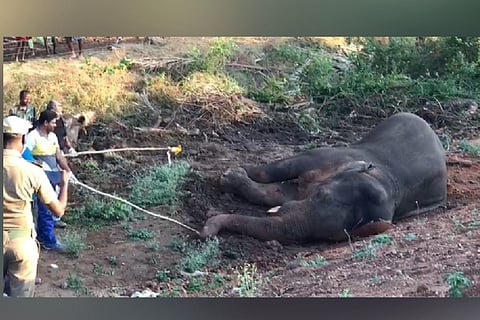

In the wee hours of March 15, a 20-year-old male elephant walked down near Pudupatti of Madukkarai forest range in Coimbatore district reportedly after drinking water at the Walayar River. During the same time, a Thiruvananthapuram-Chennai Express train started crossing the same track as the elephant and with little notice, the train struck the pachyderm, throwing the animal off by a distance. In the impact, the jumbo suffered serious injuries and soon videos started to emerge from the region showing the elephant in great pain and distress. The forest officials immediately rushed to the place and tried to provide treatment but within a few hours the elephant died at the same spot.
The 20-year-old male elephant was not the first to die due to a mishap in Madukkarai railway line. A recent RTI response from Southern Railways revealed that as many as eight wild elephants succumbed in train mishaps between Kanjikode and Madukkarai railway stations in the past five years.
The Southern Railways, responding to RTI activist R Pandiaraja of Tenkasi, said that seven of the eight deaths took place in the railway Line B passing through the dense forest while the remaining one death was reported from Line A of Madukkarai forest range. However, the Railways said that they do not have plans to shift the railway line.
The railways started taking efforts to reduce the deaths in 2017 by creating space for the elephant movement. The railways was also allocated Rs 2.43 crore in 2017 for widening the clearance to 5 kilometres along Line B for Rs 1.59 crore.
However, till now, the highest number of deaths was reported in 2019 with three elephants succumbing on Line B within a year.
According to the railways, the department has carried out efforts to place signage boards to pre-worn train drivers, to clear the vegetation on the sides of the railway track, to restrict the speed at vulnerable areas, set up low-voltage current wires to deter the elephants. They have also installed an audio alarm with a honey bee sound and are conducting sensitisation programmes for drivers and station masters.
Despite the initiative of the railways department, the environmentalists demand the government to retain a single railway line in the region. They also prevent the government to stop the deaths of elephants by installing sensors in the Line B area, to dredge the forest and create a separate pathway for the elephants.
Sunddarajan, founder of Poovulagin Nanbargal, an environmental conservation organisation, said, “We showed a strong opposition to the railway project from the time of launch since it will affect the wildlife in the region. Till now we continue our resistance against the railway line laid in the dense forest region. However, the government is not paying heed to our demand.”
“Now, we at least request the government to retain just a single line, instead of both Line A and B. Line A is located in a fragmented forest while Line B is located in a dense forest. So, the government should at least create space for the elephant movement,” he said.
The environmentalist added, “The government should install sensors so that they raise an alarm when the elephants near the track. These are also steps to reduce the mishaps but still the only solution can be to remove line B.”